Lesson Note and Plan on Mathematics
Whole numbers 1-200
Week 1, 2, 3, & 4
Subject: Mathematics
Theme: Basic operations
Topic: Whole numbers 1-200
Date: dd/mm/yyyy
Class: Basic 2
Duration: 35 Minutes
No of Learners: 30
Learning Objectives:
By the end of the lesson learners should be able to:1) count numbers correctly from 1-200;
2) identify and read numbers from 1 – 200;
3) identify order and write numbers up to 200.
Rationale:
Knowing how to count with rote counting is a little different than being able to count with rational counting. Rational counting is when children are able to allocate numbers to the objects that they’re counting. With rational counting, the child is trying to determine the quantity. However, with rote counting, they’re demonstrating that they can recite numbers in order from memoryPrerequisite/Previous knowledge:
Learners have been taught reading and writing of numbers 0–99.Learning Materials:
1. Concrete objects such as bottle tops, sticks, seeds2. Small waterproof bags for bundles of seeds/bottle tops, ropes, straws
3. Two hundred square charts etc.
4. Flash cards Sticks.
5. Charts of numbers 1-200 etc.
Reference Materials:
1) New Method Mathematics for Primary Schools 1. C. F. Oredugba, R. Ohuche, G. Salahu et al2) Understanding Maths Book 1 African First Pub. Ltd. Marian N. Daud-Osuaght
3) New Approach to Quantitative Reasoning Bk. 1 Rasmed T.A.O. Olayiwola.
Lesson Development:
| STAGE | TEACHER'S ACTIVITY | LEARNER'S ACTIVITY | LEARNING POINTS | |||||||||||||||||||||||||||||||||||||||||||||||||||||||||||||||||||||||||||||||||||||||||||||||||||||||||
|---|---|---|---|---|---|---|---|---|---|---|---|---|---|---|---|---|---|---|---|---|---|---|---|---|---|---|---|---|---|---|---|---|---|---|---|---|---|---|---|---|---|---|---|---|---|---|---|---|---|---|---|---|---|---|---|---|---|---|---|---|---|---|---|---|---|---|---|---|---|---|---|---|---|---|---|---|---|---|---|---|---|---|---|---|---|---|---|---|---|---|---|---|---|---|---|---|---|---|---|---|---|---|---|---|---|---|---|---|
| INTRODUCTION full class session (3 mins) |
The teacher revises counting from 1-99. | Learners revise counting of numbers from 1-99 using counters and 100-square charts. Learners add one counter to 99 counters, and recap that 100 is equal to 99 plus one i.e. 100 = 99 + 1 Learners read aloud 1-100 on a chart
|
Warming up and revising previous lesson on counting from1-99. | |||||||||||||||||||||||||||||||||||||||||||||||||||||||||||||||||||||||||||||||||||||||||||||||||||||||||
| The teacher begins the day's lesson by checking learners' textbook/notebook and writing materials, thereafter uses the revision exercise as a warm up for the continuation of counting, reading and writing of whole numbers 1–200. | Learners count 1-200. i.e 100 = 99 + 1, 101 = 100 + 1, 102 = 101 + 1, 103 = 102 + 1, e.t.c |
Developing the idea of the concept counting of numbers from 1-200. | ||||||||||||||||||||||||||||||||||||||||||||||||||||||||||||||||||||||||||||||||||||||||||||||||||||||||||
| DEVELOPMENT Step 1. Group Work (5 mins) |
The teacher guides the learners to form four groups and asks them to choose their leaders and secretaries. | Learners choose their group leaders and secretaries. | Inculcating leadership skills, competitive spirit, cooperation, teamwork and a sense of responsibility among learners. | |||||||||||||||||||||||||||||||||||||||||||||||||||||||||||||||||||||||||||||||||||||||||||||||||||||||||
| ACTIVITY 1 Step 2. Group Work (5 mins) Count numbers correctly from 1-200 |
The teacher guides pupils to identify and read numbers from 1- 200 in tens. | Through practical demonstrations using concrete objects and shapes, guide the pupils to layout bottle tops in
rows and columns of ten up to 200 in tens.
|
Counting up to 200 in tens | |||||||||||||||||||||||||||||||||||||||||||||||||||||||||||||||||||||||||||||||||||||||||||||||||||||||||
| ACTIVITY 2 Step 3. Group Work (5 mins) Counting of numbers from 1-200. |
The teacher guides pupils to builds up piles in tens
and units, and demonstrates that bringing three piles of
tens and eight sticks represents 38 and add 1 counter to
100 counters represents 101 counters i.e. 101 = 100 + 1, 125 = 100 + 20 + 5, e.t.c, and count numbers 1 to 200. |
Learners build up piles to correspond with the
number given and layout bottle tops in rows and columns of ten up to 100 and counted from one to two hundred (1-200)
|
Count numbers correctly from 1-200 | |||||||||||||||||||||||||||||||||||||||||||||||||||||||||||||||||||||||||||||||||||||||||||||||||||||||||
| ACTIVITY 3 Step 4. 3 mins. identify and read numbers from 1–200 |
The teacher guides the pupils in reading whole numbers 1–100, then lead them to continue from 101 to 200. The teacher guides the pupils to use flashcards with numbers. Let them raise the card and read out the number on it. | Learners identify and read aloud numbers from 1-200 on the chart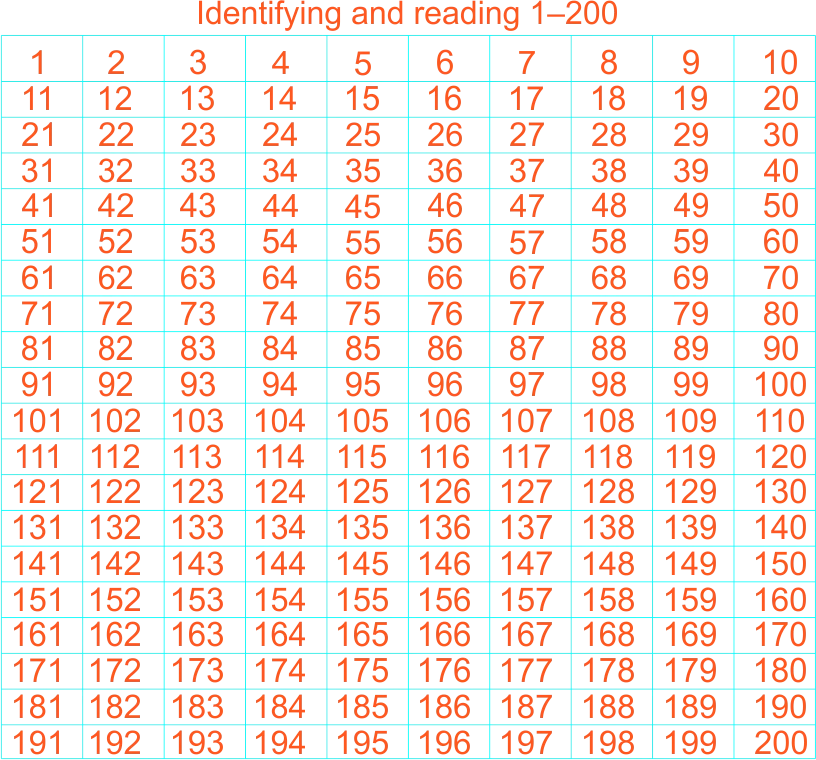
Learners spell and read aloud number 101-200 on the chart.
|
Identify and read numbers from 1-200. | |||||||||||||||||||||||||||||||||||||||||||||||||||||||||||||||||||||||||||||||||||||||||||||||||||||||||
| ACTIVITY 4 Step 5 5 mins. Introduction of place value of a number |
The teacher guides learners to builds up piles in tens and units and use bundles or piles to demonstrate place value. | Learners build up piles in hundred, tens and units using concrete objects.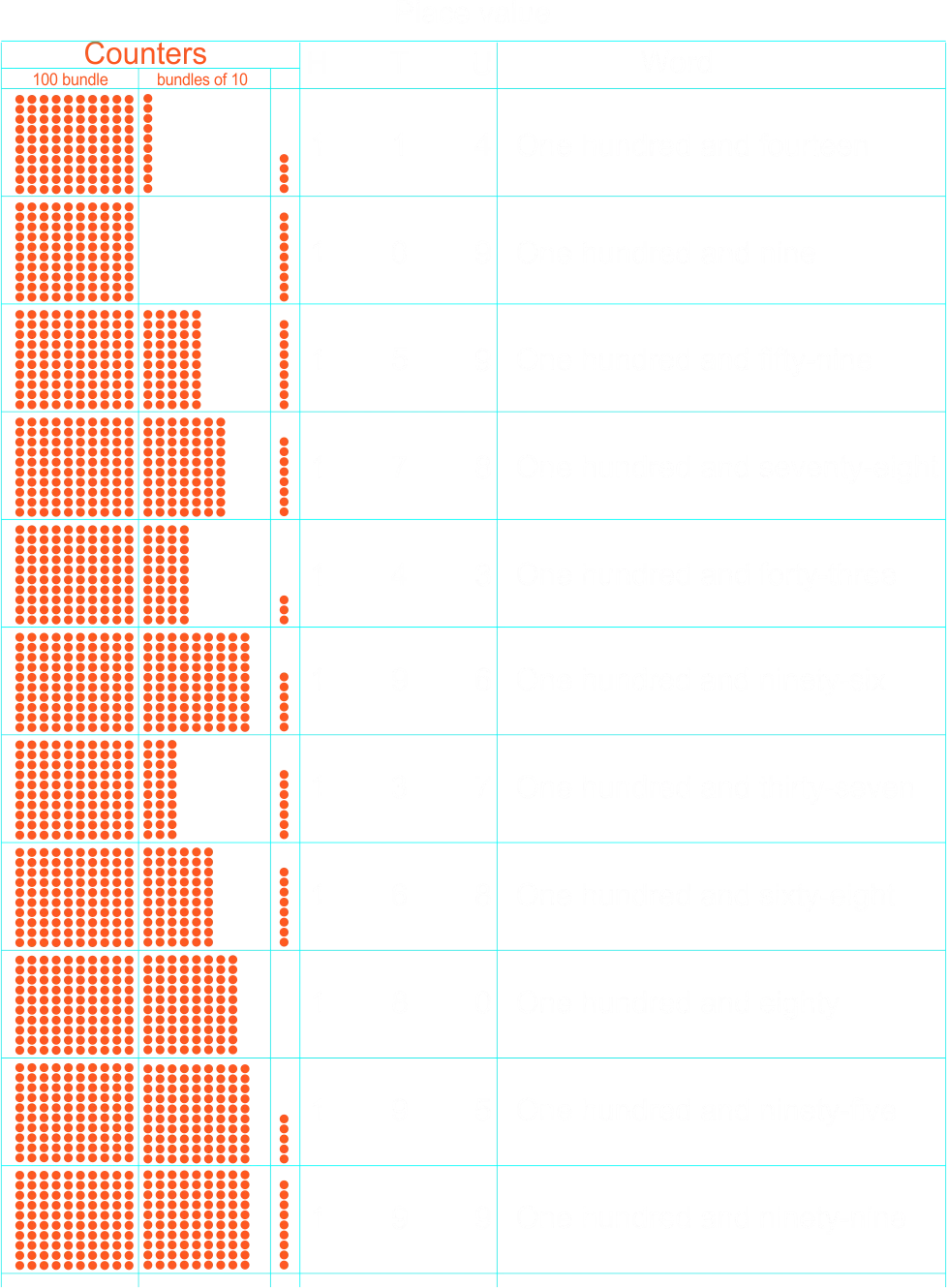
Learners count in tens and units without the use of concrete objects. 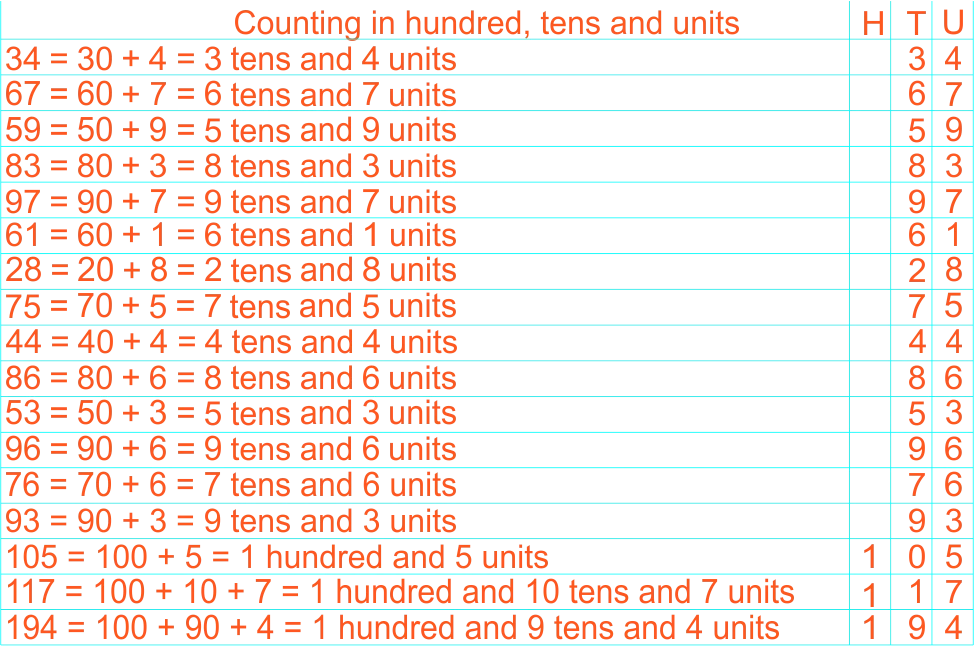
|
Place value | |||||||||||||||||||||||||||||||||||||||||||||||||||||||||||||||||||||||||||||||||||||||||||||||||||||||||
| Step 6 5 mins. Writing numerals 1–200 in words and figures |
The teacher guides the learners to write number in expanded form and use same to find place value and write numerals 1–200 in words and figures. | Learners write number in expanded form and use same to find place value to write numerals 1–200 in words and figures. 76 = 70 + 6 = 7 tens and 6 units = Seventy-six 93 = 90 + 3 = 9 tens and 3 units = Ninety-three 105 = 100 + 5 = 1 hundred and 5 units = One hundred and five 117 = 100 + 10 + 7 = 100 + 17 = One hundred and seventeen 194 = 100 + 90 + 4 = 100 + 94 = One hundred and ninety-four Forty-three = 4 tens and 3 units = 40 + 3 = 43 Eighty-five = 8 tens and 5 units = 80 + 5 = 85 One hundred and nine = 1 hundred and 9 units = 100 + 9 = 109 One hundred and fifty-three = 1 hundred 5 tens and 3 units = 100 + 50 + 3 = 153 |
Writing numerals 1–200 in words and figures | |||||||||||||||||||||||||||||||||||||||||||||||||||||||||||||||||||||||||||||||||||||||||||||||||||||||||
|
|
||||||||||||||||||||||||||||||||||||||||||||||||||||||||||||||||||||||||||||||||||||||||||||||||||||||||||||
| Step 7 5 mins Ordering numbers |
The teacher guides learners to arranged numbers in order from lowest to highest. | 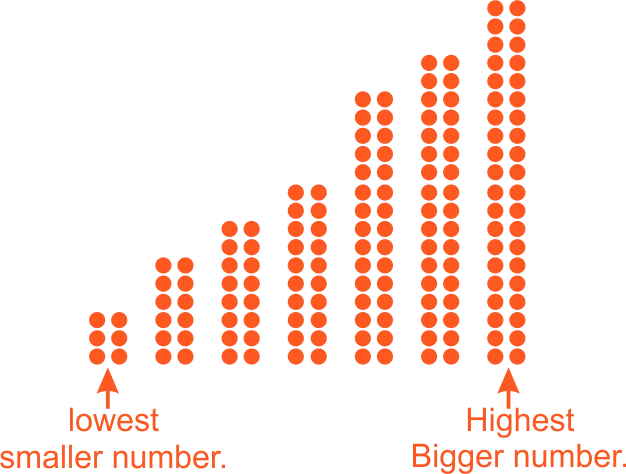
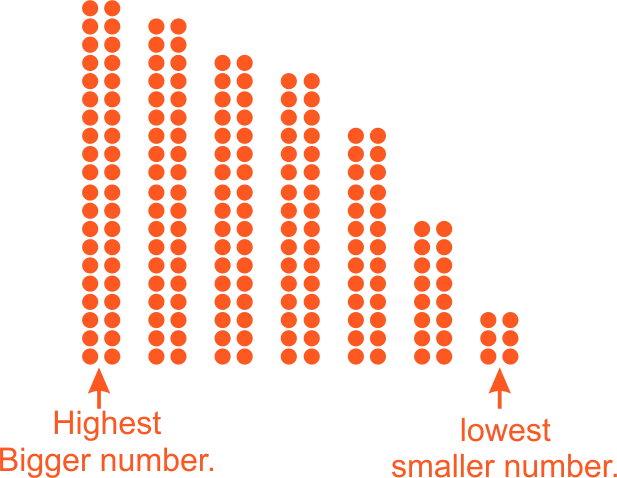
The teacher guides learners to understand that the first counters is smaller than the second counter, and the second counters is smaller than the third counters and so on Learners arrange numbers from lowest to highest 1) 176, 113, 162, 135 = 113, 135, 162, 176 2) 142, 134, 141, 146 = 134, 141, 142, 146 Learners answer questions on numbers Greater than and Less than 3) 24 is greater than 21 while 33 is less than 46 4) 62 is greater than 59 while 51 is less than 60 5) 49 is greater than 32 while 91 is less than 92 6) 109 is greater than 99 while 112 is less than 121 |
Ordering numbers | |||||||||||||||||||||||||||||||||||||||||||||||||||||||||||||||||||||||||||||||||||||||||||||||||||||||||
| Step 8 5 mins Ordinal numbers |
The teacher guides pupils to use bundles or piles to
demonstrate position and guides pupils to order given piles of numbers. The teacher tells learners that the counters are in order. We use ordinal numbers to describe their positions. "Ordinal numbers are numbers that refer to position." |
Learners order given piles of numbers using counters.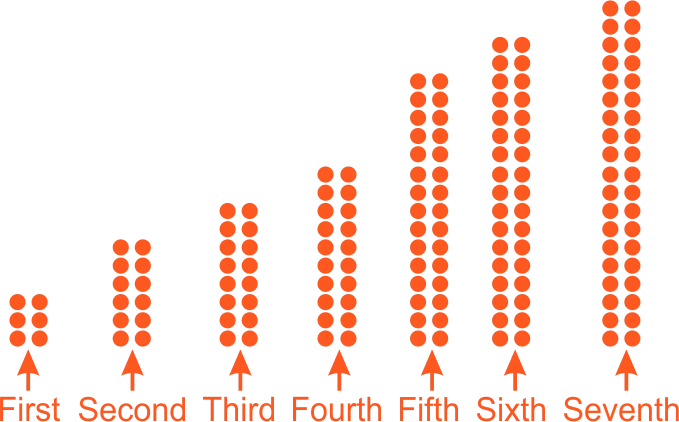
Guide the pupils to realise that each number of counter has a position. Lead them to realise that the counters in front is the first, followed by the second counters and so on. |
Ordinal numbers | |||||||||||||||||||||||||||||||||||||||||||||||||||||||||||||||||||||||||||||||||||||||||||||||||||||||||
| Evaluation Full class session (5 mins) |
Ask the following questions to evaluate the achievement of the set objectives. 1) Write out each of the following numerals in words. a) 13 = [ ] b) 27 = [ ] c) 59 = [ ] d) 181 = [ ] e) 119 = [ ] f) 143 = [ ] g) 175 = [ ] h) 190 = [ ] 2) Write out each of the following in figures. a) Eleven = [ ] b) Twenty-three = [ ] c) Forty-seven = [ ] d) Eighty = [ ] e) One Fifteen = [ ] f) One Thirty-seven = [ ] g) One Sixty-seven = [ ] h) One Ninety-two = [ ] 3) Arrange the following sets of numbers in order from smallest to highest. a) 33, 32, 30, 31, 34 b) 29, 27, 25, 28, 26 c) 40, 35, 32, 36, 31 d) 86, 66, 76, 36 e) 156, 162, 157, 164, 155, 160 f) 160, 140, 190, 130, 150, 180 4) Copy and complete the statements below with ‘less than’ or ‘greater than’. 1) 17 is _____ 46 2) 153 is _____ 139 3) 166 is _____ 163 4) 186 is _____ 199 |
Learners expected response: 1) Write out each of the following numerals in words. a) 13 = [Thirteen] b) 27 = [Twenty-seven] c) 59 = [Fifty-nine] d) 181 = [One Eighty-one] e) 119 = [One Nineteen] f) 143 = [One Forty-three] g) 175 = [One Seventy-five] h) 190 = [One Ninety] 2) Write out each of the following in figures. a) Eleven = [11] b) Twenty-three = [23] c) Forty-seven = [47] d) Eighty = [80] e) One Fifteen = [115] f) One Thirty-seven = [137] g) One Sixty-seven = [167] h) One Ninety-two = [192] 3) Arrange the following sets of numbers in order from smallest to highest. a) 33, 32, 30, 31, 34 = 30, 31, 32, 33, 34 b) 29, 27, 25, 28, 26 = 25, 26, 27, 28, 29 c) 40, 35, 32, 36, 31 = 31, 32, 35, 36, 40 d) 86, 66, 76, 36 = 36, 66, 76, 86 e) 156, 162, 157, 164, 155, 160 = 155, 156, 157, 160, 162, 164 f) 160, 140, 190, 130, 150, 180 = 130, 140, 150, 160, 180, 190 4) Copy and complete the statements below with ‘less than’ or ‘greater than’. 1) 17 is less than 46 2) 153 is greater than 139 3) 166 is greater than 163 4) 186 is less than 199 |
Confirming the achievement of the set objectives. | |||||||||||||||||||||||||||||||||||||||||||||||||||||||||||||||||||||||||||||||||||||||||||||||||||||||||
| Conclusion, full class session (3 mins) | Learners have learnt that 1) Numbers 1–200 can be counted in bundles of ten. 2) Numbers 1–200 can be written in figures and words. 3) Place value of digits can be identified in hundreds, tens and units. Fill in the blank spaces in the table below 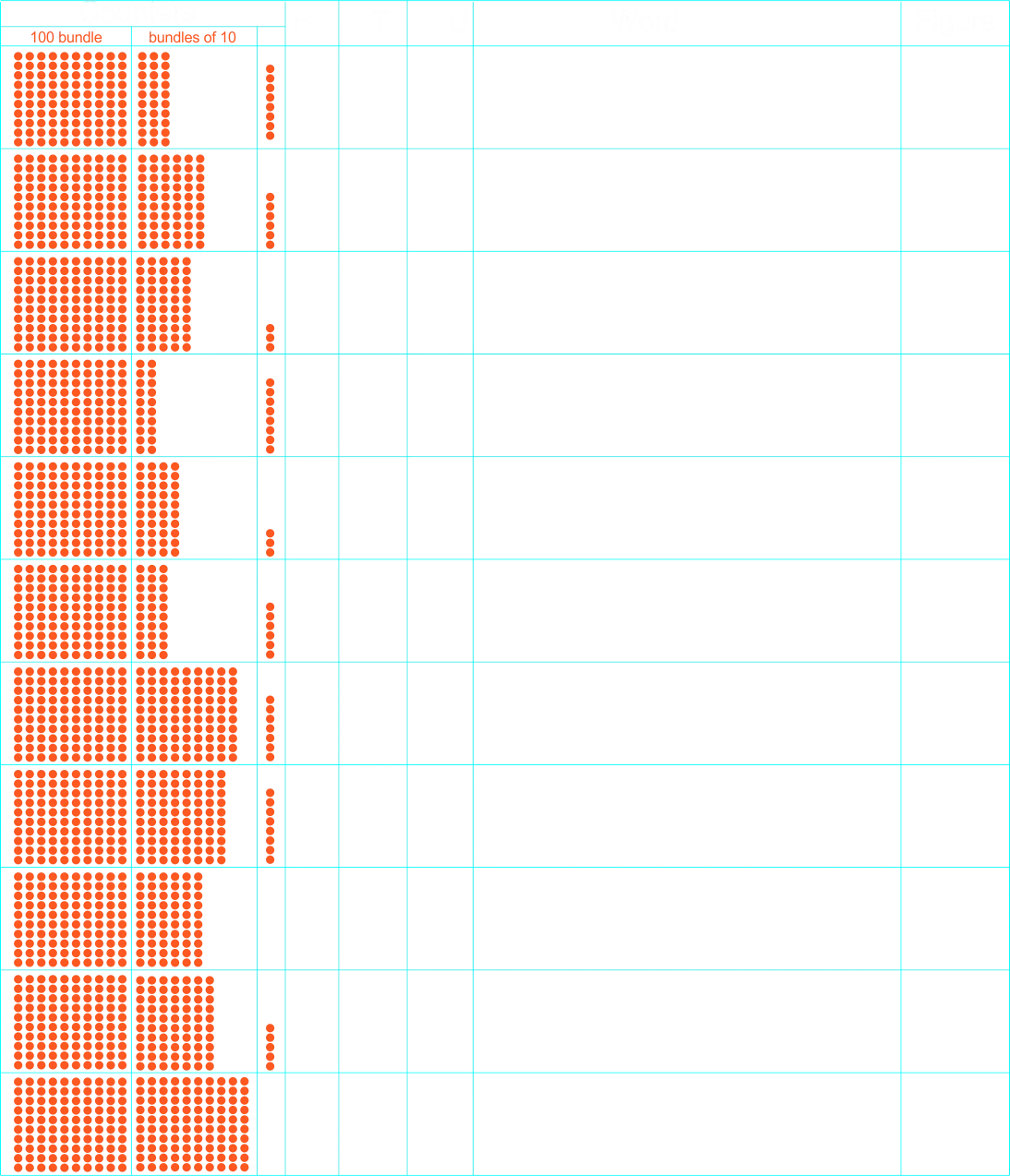
|
Learners expected answers: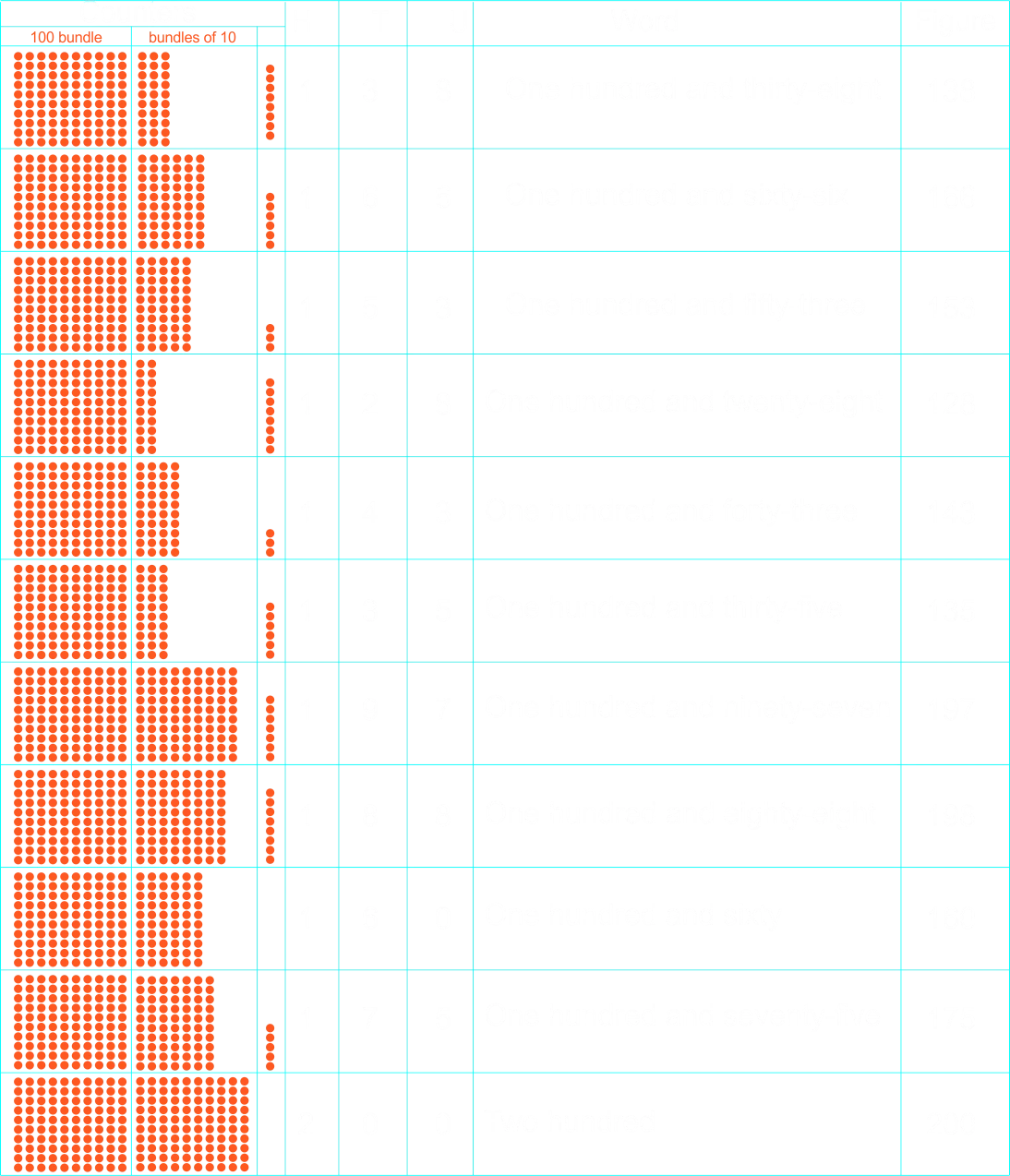
|
Communication: This is developed through answering questions verbally and interpreting the silent signs of teammates during the activities. | |||||||||||||||||||||||||||||||||||||||||||||||||||||||||||||||||||||||||||||||||||||||||||||||||||||||||
|
|
||||||||||||||||||||||||||||||||||||||||||||||||||||||||||||||||||||||||||||||||||||||||||||||||||||||||||||
| ASSIGNMENT | The teacher gives learners a take home | Copy and write out each of the following in words. 1) 36 = 2) 54 = 3) 48 = 4) 63 = 5) 70 = 6) 108 = 7) 119 = 8) 167 = 9) 189 = 10) 199 = Copy and write out the numeral for each of the following word forms. 1) Thirty-three = 2) Forty = 3) Ninety-seven = 4) One hundred and three = 5) One hundred and fifteen = 6) One hundred and thirty-eight = 7) One hundred and sixty-nine = 8) One hundred and seventy-one = 9) One hundred and eighty = 10) One hundred and ninety-six = Copy and complete the following. 1) 1 more than 47 is ____ 2) 1 less than 61 is ____ 3) 1 more than 63 is ____ 4) 1 less than 80 is ____ 5) 1 more than 89 is ____ 6) 1 less than 91 is ____ 7) 1 more than 99 is ____ 8) 1 less than 100 is ____ 9) 1 more than 110 is ____ 10) 1 less than 120 is ____ 11) 1 more than 115 is ____ 12) 1 less than 190 is ____ 13) 1 more than 199 is ____ 14) 1 less than 200 is ____ Copy and circle the greater number. 1) 49 53 2) 89 68 3) 93 104 4) 45 96 5) 175 114 6) 196 169 7) 164 156 8) 139 145 9) 193 139 10) 142 122 Copy and circle the smaller number. 1) 44 62 2) 61 17 3) 91 19 4) 91 127 5) 172 127 6) 129 191 7) 146 193 8) 155 136 9) 137 189 10) 180 159 Copy and arrange these numbers in order from lowest to highest into the box. 1) 18, 15, 17, 16 [ ] 2) 75, 74, 69, 70 [ ] 3) 91, 93, 92, 90 [ ] 4) 103, 100, 102, 104 [ ] 5) 131, 130, 129, 132 [ ] 6) 200, 198, 199, 197 [ ] 7) 110, 112, 113, 111 [ ] 8) 180, 182, 179, 181 [ ] 9) 138, 136, 137, 139 [ ] 10) 176, 179, 178, 175 [ ] |
Improving their level of understanding on Subtraction II (find missing numbers in a statement) | |||||||||||||||||||||||||||||||||||||||||||||||||||||||||||||||||||||||||||||||||||||||||||||||||||||||||